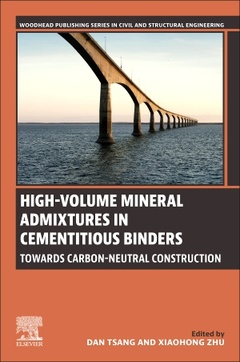High-Volume Mineral Admixtures in Cementitious Binders Towards Carbon-Neutral Construction Woodhead Publishing Series in Civil and Structural Engineering Series
Coordonnateurs : Tsang Dan, Zhu Xiaohong

High-Volume Mineral Admixtures in Cementitious Binders: Towards Carbon-Neutral Construction delivers an overview of the broad applications of high-volume supplementary cementitious materials (SCMs) in cementitious binders, addressing the most promising ways to use them to reduce carbon emissions in the construction and building industry. This book focuses on the applications and scientific challenges of high-volume SCMs blends, elaborating on the possibilities as well as offering original perspectives on using different kinds of blended cements in the manufacturing process. Emphasis is placed on activity estimation and quality assessment, the properties of high-volume SCM-blends at both the fresh and hardened stages, self-hydraulic properties, and potential use as the sole binder, as well as associated environmental impacts and carbon footprint reduction.
1. High-volume GGBS blended cements 2. High-volume Fly ash blended cements 3. High-volume biochar blended cements 4. High-volume limestone blended cements 5. High-volume waste glass powder blended cements 6. Recycled brick powder blended cements 7. High-volume recycled marble powder blended cements 8. High-volume calcined clay blended cements 9. Alkali-activated slag material: A promising option for binding sulphidic tailings 10. High-volume Municipal solid waste incineration (MSWI) fly ash blended cements 11. Utilize municipal solid waste incineration (MSWI) bottom ash in cementing materials 12. High-volume Municipal solid waste incineration (MSWI) bottom ash blended cements 13. High-volume Coal Gangue blended cements 14. High-volume steel slag blended cements 15. High-volume waste sea shell blended cements 16. High-volume red mud blended cements 17. High volume mine tailing blended cements 18. High volume rice husk ash blended cements 19. High-volume basalt waste blended cements 20. High-volume steel slag usage in construction industry 21. Sustainable cementitious binders containing high-volume red mud 22. High-volume rock wool waste blended cements 23. Sustainability evaluation of ‘green’ concrete through LCA
Prof. Tsang is the leading scientist in the fields of waste-to-resource technology, hazardous waste treatment, and carbon capture and utilization. Over the years, Dan has published more than 500 peer-reviewed papers in the top 10% journals, including 88 Highly Cited Papers as of March 2022. He was awarded as 2021-2023 Highly Cited Researcher (Clarivate Analytics) in two academic fields of Engineering as well as Environment and Ecology. He is the Chairman of the Hong Kong Waste Management Association, and the Waste Management Subcommittee of Advisory Council on the Environment, HKSAR Government. He has been invited to deliver more than 160 invited talks at international conferences and invited seminars at overseas universities. His professional contribution has been recognized by local and international communities, and he has served as the Editor-in-Chief, npj Materials Sustainability, Nature Portfolio (2023-), the Associate Editors for the top 10% journals, such as Science of the Total Environment (2018-2024), Critical Reviews in Environmental Science & Technology (2018-), Journal of Environmental Management (2022-), Journal of Hazardous Materials (2019-2021); and served as Editorial Boards for Bioresource Technology (2019-), Environmental Pollution (2019-), Chemosphere (2015-), etc.
Dr. Zhu is currently the EBI-Shell fellow at the Department of Civil and Environmental Engineering, University of California, Berkeley. He received his PhD from the University of Leeds with a thesis on the topic of morphological and structural changes of C-S-H. He has rich experience in the study of cementitious materials and published more than 50 papers in the Top Journals in this field. In the Ph.D. thesis, he explained the root causes for the morphological changes of C-A-S-H gel in the presence of high-volume supplementary cementitious materials (SCMs) at the atomic level. With the experimental observations from SS NMR and TEM-EDX, the structural-depende
- Presents the macro-/microproperties of high-volume (SCMs) cements.
- Introduces the state of the art in the use of high-volume SCM cements.
- Discusses the associated environmental impacts and the contribution to carbon neutrality by using high-volume SCMs.
- Associated with the disposal of man-made waste in the production of building materials.
- Discusses the advantages of using waste materials in cement production which reduce environmental impacts and contribute to sustainable development.
Date de parution : 09-2024
Ouvrage de 600 p.
15x22.8 cm



